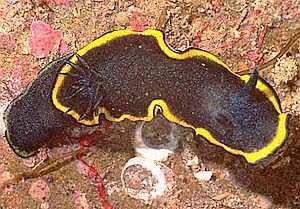
Glossodoris vespa
Rudman, 1990
Order: NUDIBRANCHIA
Suborder: DORIDINA
Family: Chromodorididae
DISTRIBUTION
Known only from southern Queensland.
PHOTO
Off Mooloolaba, Sunshine Coast, Queensland, November 1981.
Photo: Richard Willan.
The mantle is ovate with a relatively wide, but only slightly folded, mantle overlap with only one major fold on each side halfway between the gills and the rhinophores. The mantle glands are small and spherical forming a continuous line around the mantle on the inside edge of the submarginal yellow band. The mantle is black with fine white specks and a broad yellow submarginal band around the mantle skirt both dorsally and ventrally. The body and foot are also black and there is a paler yellow submarginal band around the edge of the foot. The gills and the rhinophores are also black, the gill lamellae being translucent. The gills are simple but because the blood vessels are enlarged, each gill has a broad rounded region along the dorsal and ventral edge. The gills form an arc around the anterior side of the anus before each arm of the arc curves inwards to form a spiral on each side.
Reference:
• Rudman, W.B. (1990) The Chromodorididae (Opisthobranchia: Mollusca) of the Indo-West Pacific: further species of Glossodoris, Thorunna and the Chromodoris aureomarginata colour group. Zoological Journal of the Linnean Society 100: 263-326.
Rudman, W.B., 1998 (May 26) Glossodoris vespa Rudman, 1990. [In] Sea Slug Forum. Australian Museum, Sydney. Available from http://www.seaslugforum.net/find/glosvesp
Related messages
More feeding pics of Glossodoris vespa
December 11, 2008
From: David Mullins
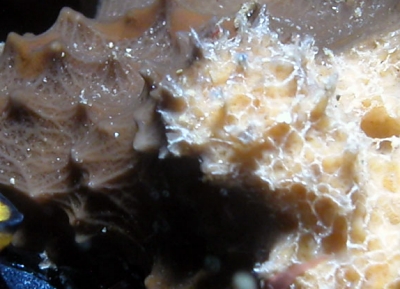
Dear Bill,
I am forwarding the attached pics to complement the recent message from Gary Cobb [#22089] showing Glossodoris vespa feeding.
After taking pics of the nudibranch feeding as we first found it, we carefully prised it off the sponge so we could photograph the feeding scar. It was then placed back just to the left of the scar and chowed down again onto the sponge straight away just as if it had not been disturbed.
Locality: Old Woman Island (Mudjimba Island) Maroochydore, Sunshine Coast,, 12 metres, Queensland, Australia., Pacific Ocean, 30 November 2008, Subtidal, Rocky reef with silty bottom. Length: 70 mm. Photographer: David Mullins.
I hope these close ups are good enough to get a sponge description.
Kind regards,
David Mullins.
marineimages@hotmail.com
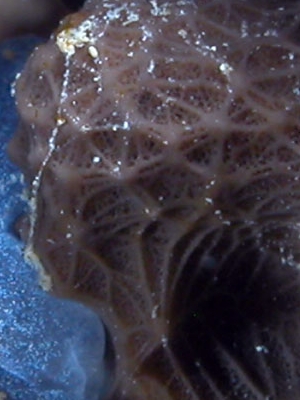
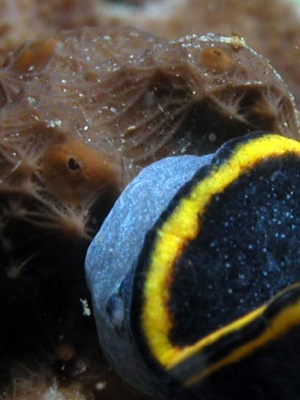
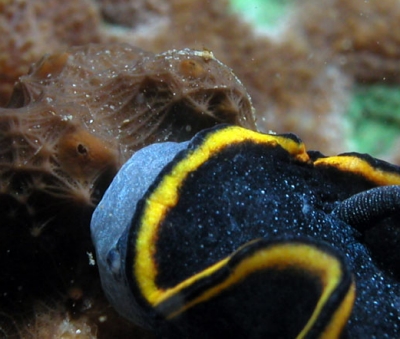
Dear David,
Thanks for these excellent photos. As I commented in Gary's message [#22089], your photos of this species and G. rubroannulata [message #20602] are of great value.
Best wishes,
Bill Rudman
Glossodoris vespa feeding
December 11, 2008
From: Gary Cobb
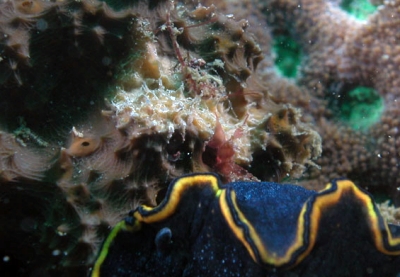
Concerning message #21282:
Hi Bill and everyone!
During today's dive we found a Glossodoris vespa well and truly feeding. You can see the buccal mass and the brown sponge. I moved the animal so you could see the feeding scar.
Locality: Old Woman Island, Mooloolaba, Sunshine Coast, 12 m, Queensland, Australia, Pacific Ocean, 30 November 2008, Subtidal. Length: 70mm. Photographer: Gary Cobb.
Cheers,
Gary
gary@nudibranch.com.au
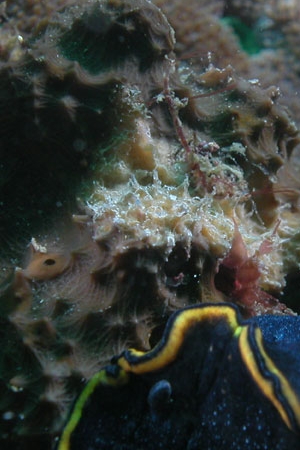
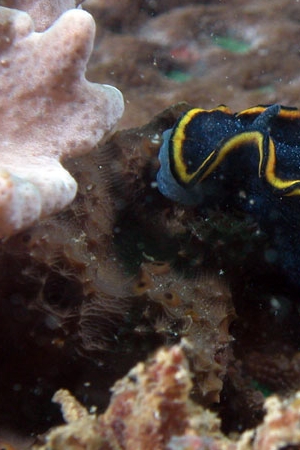
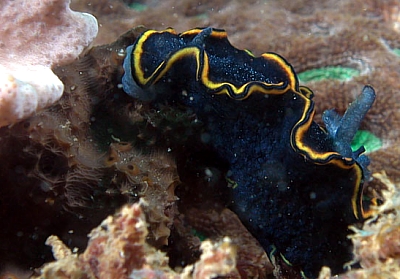
Dear Gary,
Thanks for this excellent find. With Dave Mullins' photos [message #22094] which I am also posting today, I should be able to get this sponge identified. Interestingly it looks very similar to the sponge in Dave's earlier message showing G. rubroannulata feeding [message #20602]. I have almost got enough new sponge records now to arrange a session with Prof Bergquist to check their identities. From the available information, species of Glossodoris feed exclusively on thorectid sponges, but as we all know, these slugs don't seem to keep up with the scientific literature. To my untutored eye these sponges look more like dysideids, but I need expert advice. Interestingly both G. rubroannulata and G. vespa belong to a group of species which don't fit well in the genus Glossodoris, having a Chromodoris-like wide radular ribbon and body shape. So if the food does turn out to be non-thorectid it may be more evidence to show that the genus Glossodoris needs splitting up. With your earlier posts, you and Dave have given us much valuable information on the biology of this species.
Best wishes,
Bill Rudman
Glossodoris vespa hatching today
February 8, 2008
From: Gary Cobb
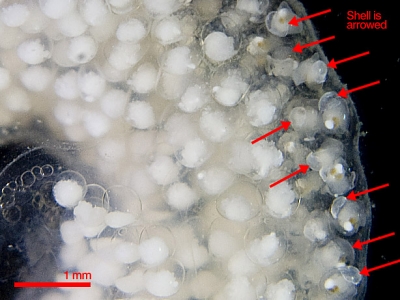
Hi Bill and everyone!
Well after 28 days the developing embryos are now crawling around [7 December 2007]. There are some interesting bits to tell. I have noticed that all along the yolks and embryos were always at the bottom of the egg capsule probably because of gravity. After two weeks I noticed the embryos were all sitting up with velar lobes facing up. On an earlier drawing I sent you 'C' was indeed the shell which was on the bottom of the embryo. The little nudibranchs were born with 2 rhinophores. The mantle was transparent and appeared to have spicules. Maybe you can help with ID of the inner parts. The eye spots are very prominent and so is the beautiful tail!
The shells were left in the mass after the animal departed. They appear to be a semispherical cap. Do you think the embryos were facing up because of the weight of the shell?
I also think that with this species the reason it has a very restricted geographic range is because the egg mass is laid on the food source and the animal hatches directly and starts to feed...no need to drift for miles!
Locality: Adults-Old Woman Island, Mooloolaba, Sunshine Coast, Adults 14 m, Queensland, Australia, Pacific Ocean, 07 December 2007, Jar-kitchen. Length: Infants under 1 mm. Photographer: Gary Cobb.
Thanks
Gary Cobb (Dad)
gary@nudibranch.com.au
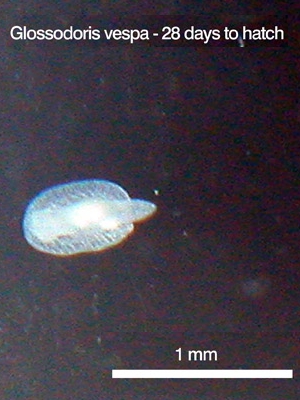
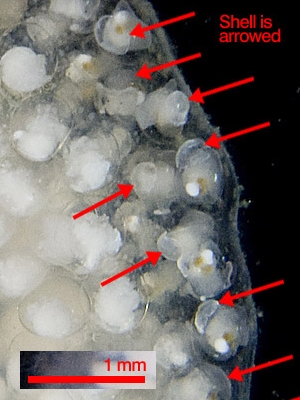
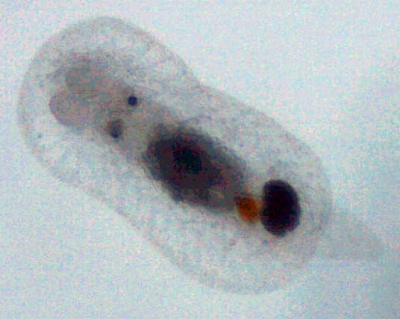
Dear Gary,
Thanks for this great series of observations on the development of Glossodoris vespa. I am sorry I wasn't able to post them immediately but they are a very valuable record. Concening your question about whether the weight of the eggs affected the way the embryos were arranged in the egg capsule I think it is probably the weight of the viscera and the current caused by the ciliated velar lobes which had more affect on the way the embryos were sitting. I must admit from my experience the embryos tend to revolve a lot in the capsules, but as direct developers reach hatching time they lose the velar lobes and get a bit big for moving in their capsule.
As a general rule I think we can say direct developers have a restricted geographic range but as I discussed earlier [message #21049] there are exceptions.
Best wishes,
Bill Rudman
Glossodoris vespa eggs - progress report
December 11, 2007
From: Gary Cobb
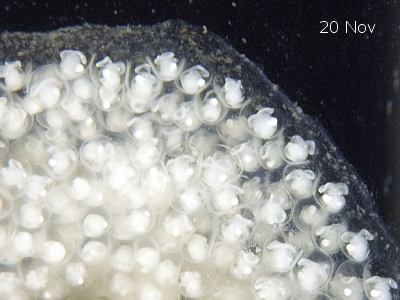
Hi Bill and everyone!
Here are two photos of the egg mass of Glossodoris vespa that I have been observing. Note the differences between the two. The embryos toward the center seem to be dying off due to the fresh seawater not getting to them. Also notice how the embryos on the outside have seemed to have lost their egg capsule and are closer to the edge of the mass.
The dates of the two photos are 20-Nov-07 and 01-Dec-07 which is 11 days difference. Remember, the eggs were laid 08-Nov-07
Locality: Old Woman Island, Sunshine Coast, 14 m, Queensland, Australia, Pacific Ocean, 01 December 2007, Subtidal. Length: 38 mm. Photographer: Ross Eason.
Cheers
Gary Cobb
gary@nudibranch.com.au
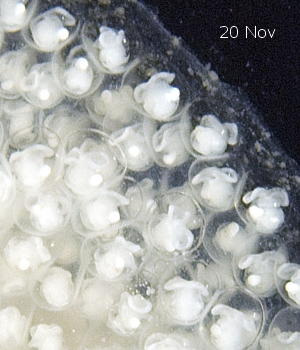
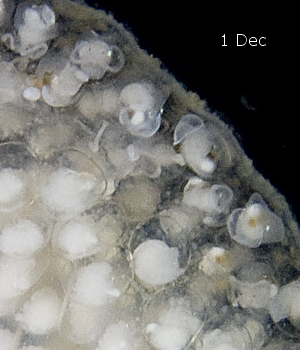
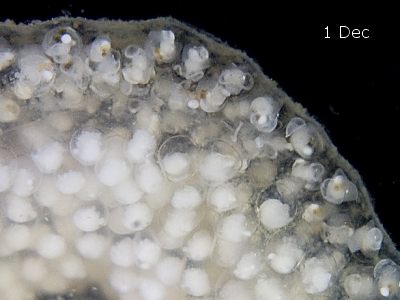
Thanks Gary,
Bill Rudman
Rudman, W.B., 2007 (Dec 11). Comment on Glossodoris vespa eggs - progress report by Gary Cobb. [Message in] Sea Slug Forum. Australian Museum, Sydney. Available from http://www.seaslugforum.net/find/21266Glossodoris vespa eggs at 10 days old
November 21, 2007
From: Gary Cobb
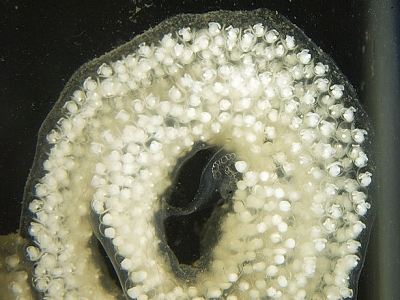
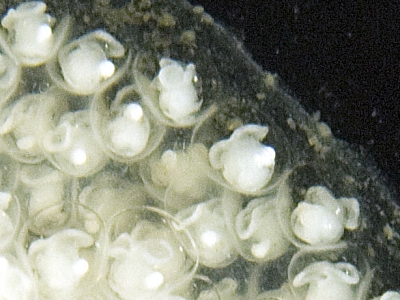
HI Bill and everyone!
Following on yesterday's message of Glossodoris vespa [#21152] showing the eggs at 9 days, here are photos after 10 days - and what a view! I drew a line drawing and was wondering if you could indentify the parts. Will they develop more and will the shape change too??
Locality: Old Woman Island, Mooloolaba, Sunshine Coast, 14 m, Queensland, Australia, Pacific Ocean, 20 November 2007, Subtidal. Length: 38 mm. Photographer: Ross Eason.
Thanks
Gary Cobb
gary@nudibranch.com.au
Cobb, G.C., 2007 (Nov 21) Glossodoris vespa eggs at 10 days old. [Message in] Sea Slug Forum. Australian Museum, Sydney. Available from http://www.seaslugforum.net/find/21168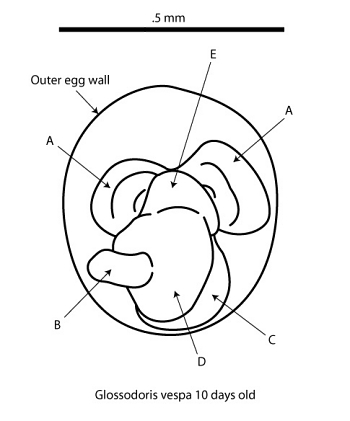
Dear Gary,
Another interesting post. Opisthobranch eggs can develop in a number of different ways. The most primitive way, and probably the most common is what is called planktotrophic in which the fertilised egg begins to divide and develops into a shelled veliger larvae with large wing-shaped velar lobes. This veliger larvae hatched out of the egg capsule and swims away, feeding on one-celled algae for a time before settling out of the plankton and turning into a microscopic crawling slug. A second type of development is called lecithotrophic and in this case a swimming veliger larvae emerges from the egg capsule, but does not feed in the plankton, and spends only a few hours to days in the plankton before turning into a small slug.
The third development type is called direct development because the embryo turns into a crawling slug within the egg capsule and hatches out as a small crawling slug. There is a whole range of direct developers from those which shpw no real sign of a veliger larvae in the grwth of the embryo to others which go through a recognisable veliger stage in the egg capsule before dropping the shell and turning into a slug all within the egg capsule.
I previously referred to Nerida Wilson's paper where she reports the development of Glossodoris vespa as ametamorphic direct which means that the embryo doesn't develop into a recognisable veliger larvae in the egg capsule before turning into a crawling slug. 'Ametamorphic direct' is a term given to species in which there is little sign of a veliger stage. However the A structures in your drawing are velar lobes, so they are quite a bit larger than I would expect in a species with ametamorphic development. However they don't seem to have long cilia along the edge so we can probably call them vestigial. Labelling development types is difficult because there are always species which straddle the border between one type and another.
I am not sure of all the structures you have labelled but here is my best guess:
A, velar lobes
B, I guess this is the white structure in your photos. I suspect this is the larval kidney - a temporary structure lost after hatching.
C, This is probably the larval shell. In direct developer it is often reduced to a semispherical cap.
D, the body.
E, this is the larval foot.
I hope the larvae stay healthy until they hatch. It could be another couple of weeks before they do. I am not sure how you are keeping the egg ribbon but it may be an idea to change its water regularly.
- Wilson, N. G. (2002). Egg masses of chromodorid nudibranchs (Mollusca: Gastropoda: Opisthobranchia). Malacologia, 44(2): 289-305
Good luck,
Bill Rudman
Re: Egg mass of Glossodoris vespa
November 20, 2007
From: Gary Cobb
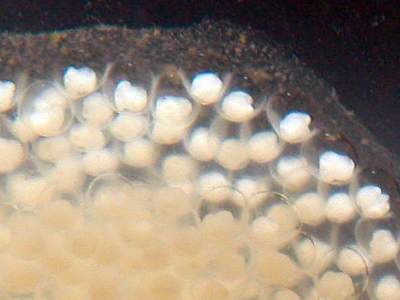
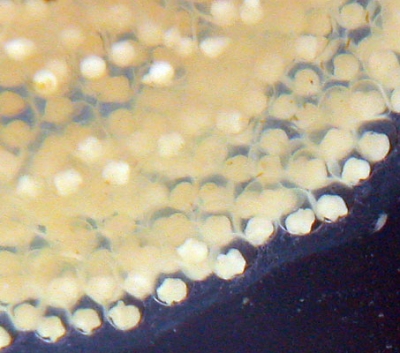
Concerning message #21104:
Hi Bill and everyone!
Here is another instalment of the development of the Glossodoris vespa egg mass. Here are photos of the mass and eggs after 9 days. You can clearly see that the yolks are developing just fine. Yolks have formed lumps that will hopefully grown into nudibranchs.
Cheers
Gary Cobb
gary@nudibranch.com.au
Cobb, G.C., 2007 (Nov 20) Re: Egg mass of Glossodoris vespa. [Message in] Sea Slug Forum. Australian Museum, Sydney. Available from http://www.seaslugforum.net/find/21152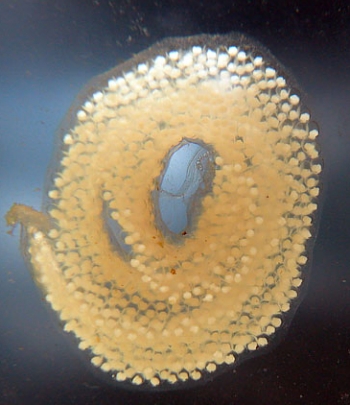
Dear Gary,
Thanks for keeping us up to date with the development of these eggs. What you are calling the yolks are in fact ther embryo - its starts as a fertilised egg and then through cell division gradually develops as an multicellular embryo. In slugs with planktonic veliger larvae the embryo develops into a shelled veliger larva which hatches out of the egg capsule and swims away. In G. vespa the embryo develops into a small crawling slug so if we are lucky you will be able to see and photograph baby slugs hatching out. The only problem is we still aren't clear on what this species eats. Unless you can discover that before the babies arrive then I am afraid they will starve.
Best wishes,
Bill Rudman
Egg mass of Glossodoris vespa
November 10, 2007
From: Gary Cobb
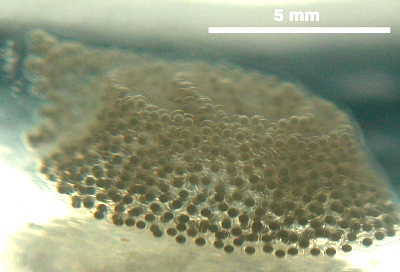
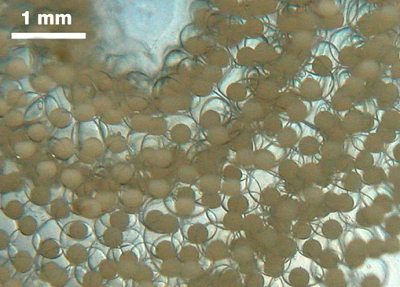
Hi Bill and everyone!
Concerning your request in message #21049 - Well the wait is over. After 6 days of observing, a 38 mm long Glossodoris vespa has finally laid an egg mass. Measurements are indicated on the photos. The mass in upright and sloping inward. There are two whorls. The yolks are about .25 mm in diameter and are cream in colour. Note how gravity has pulled all the yolks to the bottom of the egg capsule which is clear and have no extra-capsular yolk. Also note two photos were taken from the the ventral view and you can see the tops raising out of focus.
Locality: Old Woman Island, Mooloolaba, Sunshine Coast, 14 m, Queensland, Australia, Pacific Ocean, 09 November 2007, Subtidal. Length: 38 mm. Photographer: Gary Cobb.
I hope this observation can of be useful.
Cheers
Gary Cobb
gary@nudibranch.com.au
Cobb, G.C., 2007 (Nov 10) Egg mass of Glossodoris vespa. [Message in] Sea Slug Forum. Australian Museum, Sydney. Available from http://www.seaslugforum.net/find/21104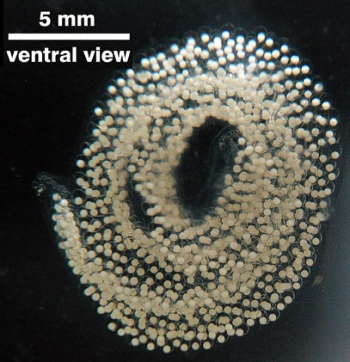
Dear Gary,
Thanks very much. This egg mass fits Nerida Wilson's report so its very good to get some illustrations of it. She reports the development to be ametamorphic which means the larvae, as they develop, don't go through a veliger stage. The egg just begins to divide and gradually develops directly into a small crawling slug. Its interesting to see an example of an egg ribbon in which the ribbon slopes inwards.
Best wishes,
Bill Rudman
Re: Glossodoris vespa endemic to sthn Queensland
October 31, 2007
From: David Mullins
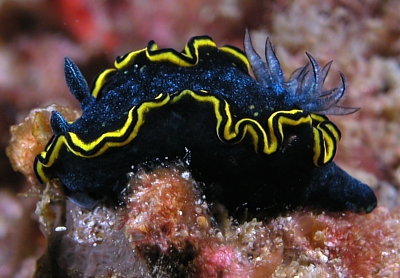
Concerning message #20096:
Dear Bill,
Possibly due to the fact that Glossodoris vespa develops directly thereby limiting its distribution and causing it to be endemic to the S.E. Queensland area there are not many messages on the forum concerning its natural history.
Locality: Inner Gneerings, Maroochydore,, 15 metres, Queensland, Australia., Pacific Ocean, 01 August 2004, rocky reef. Length: 50 mm. Photographer: David Mullins.
Herewith a pic of Glossodoris vespa feeding, however there may be insufficient detail (despite the high rez) in the sponge prey to be of use to the forum. To "catch it in the act" so to speak is normally difficult as it posseses such a wide mantle that obscures the evidence.
We shall continue the hunt nevertheless.
Kind regards,
David Mullins.
david@nudibranch.com.au
Mullins, D.A., 2007 (Oct 31) Re: Glossodoris vespa endemic to sthn Queensland. [Message in] Sea Slug Forum. Australian Museum, Sydney. Available from http://www.seaslugforum.net/find/21049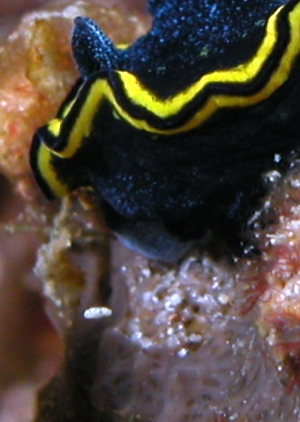
Dear David,
Thanks very much. You are probably correct in thinking I won't be able to get the sponge identified. I must say I used to think sponges were very good at keeping themselves clean of growths, and some certainly are, but unfortunately some of the main food choices of chromodorids seem to have evolved the ability to cope with being almost completely overgrown.
At the risk of seeming greedy, it would be nice to see a photo of this species' egg ribbon. As far as I know the only record is Nerida Wilson's report (2002) of a single egg ribbon, with whitish cream eggs, from the Gneering Shoals.
You are probably right in suggesting its direct development has restricted its geographical distribution, but there are some amazing exceptions to the rule that direct development means restricted distributions. One that comes to mind is Vayssierea felis which is a small species with a large Indo-West Pacific distribution. However this anomaly can be explained by its habit of living on floating algae which means the eggs rather than the larvae can be moved large distances. Another more spectacular example is the bright red sea anemone, Actinia tenebrosa, which is found all around New Zealand, and temperate Australia, and as far north as Shark Bay on the west coast and Heron Island on the east coast. Its main means of reproduction is to bud off small clones which pop out of its mouth to form a little cluster of babies on the rock around the parent. You can't get much more direct than that. One would expect populations to be genetically isolated, but a number of comprehensive studies suggest there is as much genetic variability as you would expect in a species with planktonic larvae. I don't know what it all means other than to be cautious of saying direct development always means a restricted distribution.
-
Wilson, N. G. (2002). Egg masses of chromodorid nudibranchs (Mollusca: Gastropoda: Opisthobranchia). Malacologia, 44(2): 289-305
Best wishes,
Bill Rudman
Glossodoris vespa endemic to southern Queensland, Austr
July 4, 2007
From: Gary Cobb
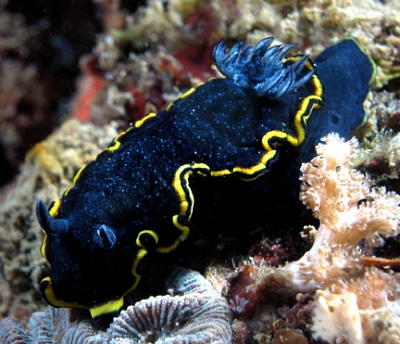
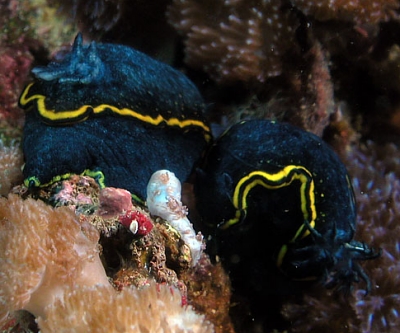
Hi Bill!
Good to see you're busy ... need help?? I thought I would update your Forum fact sheet with a beautiful species endemic to the Sunshine Coast Queensland, Australia that you described. Glossodoris vespa is pretty common here and we see it on about every other dive!
Locality: Sunshine Coast near Mooloolaba, 6-24 m, Queensland, Australia, Pacific Ocean, 30 June 2007, Subtidal. Length: 70-95 mm. Photographer: David Mullins and Gary Cobb.
Cheers and happy branching!
Gary
gary@nudibranch.comau
Cobb, G.C., 2007 (Jul 4) Glossodoris vespa endemic to southern Queensland, Austr. [Message in] Sea Slug Forum. Australian Museum, Sydney. Available from http://www.seaslugforum.net/find/20096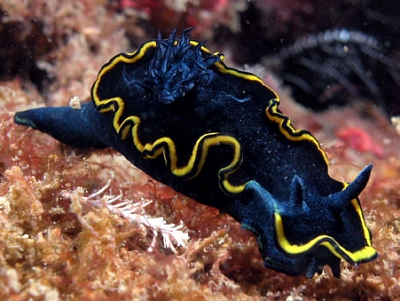
Dear Gary,
Thanks for some more photos of this species which certainly seems to be found only in southern Queensland. I must say your comment that it is pretty common interests me. Perhaps you could keep an eye out for one laying eggs or even better - eating a sponge.
Best wishes,
Bill Rudman
Glossodoris from Mooloolaba
May 26, 1998
From: Wayne Ellis
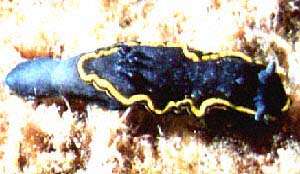
Bill,
Here is another of Steve Grail's photos for identification. He basically told me the pics were taken 10-20m, between 1996-98 off Mooloolaba.
Regards,
Wayne Ellis
glaskin@ozemail.com.au
Ellis, W., 1998 (May 26) Glossodoris from Mooloolaba. [Message in] Sea Slug Forum. Australian Museum, Sydney. Available from http://www.seaslugforum.net/find/65This is Glossodoris vespa which is at present only known from southern Queensland. It is quite similar in shape and anatomy to Glossodoris cincta, but its colour pattern is quite unique. I named it "vespa" which is "wasp" in Latin because of its black and yellow colour.
Rudman, W.B., 1998 (May 26). Comment on Glossodoris from Mooloolaba by Wayne Ellis. [Message in] Sea Slug Forum. Australian Museum, Sydney. Available from http://www.seaslugforum.net/find/65